作者:京东科技 王奕龙
1. 验证二级缓存
在上一篇帖子中的 User 和 Department 实体类依然要用,这里就不再赘述了,要启用二级缓存,需要在 Mapper.xml 文件中指定 cache 标签,如下:
UserMapper.xml
<select id="findAll" resultType="User"> select * from user </select>
<cache />
复制代码
Department.xml
<select id="findAll" resultType="entity.Department"> select * from department; </select> <cache readOnly="true"/>
复制代码
在 Department.xml 中的 cache 标签指定了 readOnly 属性,因为该配置相对比较重要,所以我们在这里把它讲解一下:
readOnly 默认为 false,这种情况下通过二级缓存查询出来的数据会进行一次 序列化深拷贝。在这里大家需要回想一下介绍一级缓存时举的例子:一级缓存查询出来返回的是 该对象的引用,若我们对它修改,再查询 时触发一级缓存获得的便是 被修改过的数据。但是,二级缓存的序列化机制则不同,它获取到的是 缓存深拷贝的对象,这样对二级缓存进行修改操作不影响后续查询结果。
如果将该属性配置为 true 的话,那么它就会变得和一级缓存一样,返回的是对象的引用,这样做的好处是 避免了深拷贝的开销。
为什么会有这种机制呢?
因为二级缓存是 Mapper 级别 的,不能保证其他 SqlSession 不对二级缓存进行修改,所以这也是一种保护机制。
我们验证一下这个例子,Department 和 User 的查询都执行了两遍(注意 事务提交之后 才能使二级缓存生效):
public static void main(String[] args) { InputStream xml = Resources.getResourceAsStream("mybatis-config.xml"); SqlSessionFactoryBuilder sqlSessionFactoryBuilder = new SqlSessionFactoryBuilder(); // 开启二级缓存需要在同一个SqlSessionFactory下,二级缓存存在于 SqlSessionFactory 生命周期,如此才能命中二级缓存 SqlSessionFactory sqlSessionFactory = sqlSessionFactoryBuilder.build(xml);
SqlSession sqlSession1 = sqlSessionFactory.openSession(); UserMapper userMapper1 = sqlSession1.getMapper(UserMapper.class); DepartmentMapper departmentMapper1 = sqlSession1.getMapper(DepartmentMapper.class);
System.out.println("----------department第一次查询 ↓------------"); List<Department> departments1 = departmentMapper1.findAll(); System.out.println("----------user第一次查询 ↓------------"); List<User> users1 = userMapper1.findAll();
// 提交事务,使二级缓存生效 sqlSession1.commit();
SqlSession sqlSession2 = sqlSessionFactory.openSession(); UserMapper userMapper2 = sqlSession2.getMapper(UserMapper.class); DepartmentMapper departmentMapper2 = sqlSession2.getMapper(DepartmentMapper.class);
System.out.println("----------department第二次查询 ↓------------"); List<Department> departments2 = departmentMapper2.findAll(); System.out.println("----------user第二次查询 ↓------------"); List<User> users2 = userMapper2.findAll();
sqlSession1.close(); sqlSession2.close();}
复制代码
Department 和 User 的同一条查询语句都执行了两遍,因为 Department 指定了 readOnly 为 true,那么 两次查询返回的对象均为同一个引用,而 User 则反之,Debug 试一下:
cache 的其他属性
接下来我们测试验证下二级缓存的生效:
SqlSession sqlSession1 = sqlSessionFactory.openSession(); DepartmentMapper departmentMapper1 = sqlSession1.getMapper(DepartmentMapper.class);
System.out.println("----------department第一次查询 ↓------------"); List<Department> departments1 = departmentMapper1.findAll();
// 使二级缓存生效 sqlSession1.commit();
SqlSession sqlSession2 = sqlSessionFactory.openSession(); DepartmentMapper departmentMapper2 = sqlSession2.getMapper(DepartmentMapper.class);
System.out.println("----------department第二次查询 ↓------------"); List<Department> departments2 = departmentMapper2.findAll();
复制代码
第一次 Query,会去数据库中查
第二次 Query,直接从二级缓存中取
二级缓存对象 Cache
在加载 Mapper 文件(org.apache.ibatis.builder.xml.XMLConfigBuilder#mappersElement 方法)时,定义了加载 cache 标签的步骤(org.apache.ibatis.builder.xml.XMLMapperBuilder#configurationElement 方法),代码如下:
public class XMLMapperBuilder extends BaseBuilder { // ... private void configurationElement(XNode context) { try { // 若想要在多个命名空间中共享相同的缓存配置和实例,可以使用 cache-ref 元素来引用另一个缓存 cacheRefElement(context.evalNode("cache-ref")); // 配置二级缓存 cacheElement(context.evalNode("cache")); // ... } catch (Exception e) { throw new BuilderException("Error parsing Mapper XML. The XML location is '" + resource + "'. Cause: " + e, e); } }}
复制代码
具体解析逻辑如下:
public class XMLMapperBuilder extends BaseBuilder { // ... private void cacheElement(XNode context) { if (context != null) { // 二级缓存实现类,默认 PerpetualCache,我们在一级缓存也提到过 String type = context.getStringAttribute("type", "PERPETUAL"); Class<? extends Cache> typeClass = typeAliasRegistry.resolveAlias(type); // 缓存清除策略,默认 LRU String eviction = context.getStringAttribute("eviction", "LRU"); Class<? extends Cache> evictionClass = typeAliasRegistry.resolveAlias(eviction); // 定时清除间隔 Long flushInterval = context.getLongAttribute("flushInterval"); // 缓存引用数量 Integer size = context.getIntAttribute("size"); // readOnly上文我们提到过,默认 false boolean readWrite = !context.getBooleanAttribute("readOnly", false); // blocking 默认 false boolean blocking = context.getBooleanAttribute("blocking", false); Properties props = context.getChildrenAsProperties(); // 创建缓存对象 builderAssistant.useNewCache(typeClass, evictionClass, flushInterval, size, readWrite, blocking, props); } }}
复制代码
我们继续看创建二级缓存对象的逻辑 org.apache.ibatis.builder.MapperBuilderAssistant#useNewCache,可以发现,创建 Cache 对象使用了 建造者模式:
建造者 CacheBuilder 并没有被组合在任意一种缓存的实现类中,而是根据如下代码中 implementation(valueOrDefault(typeClass, PerpetualCache.class)) 逻辑指定了要创建的缓存类型,并在 build 方法中使用反射创建对应实现类:
public class MapperBuilderAssistant extends BaseBuilder { // ...
public Cache useNewCache(Class<? extends Cache> typeClass, Class<? extends Cache> evictionClass, Long flushInterval, Integer size, boolean readWrite, boolean blocking, Properties props) { // 建造者模式,将标签属性赋值 Cache cache = new CacheBuilder(currentNamespace).implementation(valueOrDefault(typeClass, PerpetualCache.class)) .addDecorator(valueOrDefault(evictionClass, LruCache.class)).clearInterval(flushInterval).size(size) .readWrite(readWrite).blocking(blocking).properties(props).build();
// 添加到全局配置中 configuration.addCache(cache); currentCache = cache; return cache; }}
复制代码
其中 addDecorator(valueOrDefault(evictionClass, LruCache.class)) 逻辑添加了 装饰器,使用了 装饰器模式,将 LruCache 类型的装饰器添加到 decorators 中:
public class CacheBuilder {
private final List<Class<? extends Cache>> decorators;
public CacheBuilder addDecorator(Class<? extends Cache> decorator) { // 将 LruCache 装饰器添加到 decorators if (decorator != null) { this.decorators.add(decorator); } return this; } // ...}
复制代码
在 CacheBuilder#build 方法中,如下为封装装饰器的逻辑:
public class CacheBuilder { // ...
public Cache build() { setDefaultImplementations(); // 反射创建 PerpetualCache Cache cache = newBaseCacheInstance(implementation, id); setCacheProperties(cache);
// 封装装饰器的逻辑 if (PerpetualCache.class.equals(cache.getClass())) { for (Class<? extends Cache> decorator : decorators) { cache = newCacheDecoratorInstance(decorator, cache); setCacheProperties(cache); } // 初始化基础必要的装饰器 cache = setStandardDecorators(cache); } else if (!LoggingCache.class.isAssignableFrom(cache.getClass())) { cache = new LoggingCache(cache); } return cache; }
private Cache setStandardDecorators(Cache cache) { try { MetaObject metaCache = SystemMetaObject.forObject(cache); if (size != null && metaCache.hasSetter("size")) { metaCache.setValue("size", size); } // 定时清空二级缓存 if (clearInterval != null) { cache = new ScheduledCache(cache); ((ScheduledCache) cache).setClearInterval(clearInterval); } // readOnly属性相关的读写缓存 if (readWrite) { cache = new SerializedCache(cache); } // 日志缓存和同步缓存(借助 ReentrantLock 实现) cache = new LoggingCache(cache); cache = new SynchronizedCache(cache); // 阻塞属性的缓存 if (blocking) { cache = new BlockingCache(cache); } return cache; } catch (Exception e) { throw new CacheException("Error building standard cache decorators. Cause: " + e, e); } }
}
复制代码
所有装饰器都在 org.apache.ibatis.cache.decorators 包下,唯独 PerpetualCache 在org.apache.ibatis.cache.impl 包下:
PerpetualCache 中不包含 delegate 属性表示装饰器,说明它将作为最基础的实现类被其他装饰器装饰,而其他装饰器中均含有 delegate 属性来装饰其他实现。
默认创建的二级缓存类型如下:
类关系图如下:
query 方法对二级缓存的应用
org.apache.ibatis.executor.CachingExecutor#query 方法使用了二级缓存,如下代码所示:
public class CachingExecutor implements Executor {
// 事务缓存管理器 private final TransactionalCacheManager tcm = new TransactionalCacheManager(); @Override public <E> List<E> query(MappedStatement ms, Object parameterObject, RowBounds rowBounds, ResultHandler resultHandler, CacheKey key, BoundSql boundSql) throws SQLException { // 先获取二级缓存,该对象便是上文中创建的被装饰器装饰的 PerpetualCache Cache cache = ms.getCache(); if (cache != null) { // 判断是否需要清除缓存 flushCacheIfRequired(ms); if (ms.isUseCache() && resultHandler == null) { ensureNoOutParams(ms, boundSql); // 从二级缓存中取 @SuppressWarnings("unchecked") List<E> list = (List<E>) tcm.getObject(cache, key); if (list == null) { // 没取到二级缓存,尝试取一级缓存或去数据库查询 list = delegate.query(ms, parameterObject, rowBounds, resultHandler, key, boundSql); // “添加二级缓存” tcm.putObject(cache, key, list); // issue #578 and #116 } return list; } } // 没有二级缓存的话,执行的是我们在一级缓存中介绍的方法,要么取一级缓存,否则去数据库查 return delegate.query(ms, parameterObject, rowBounds, resultHandler, key, boundSql); } // ...}
复制代码
上述逻辑比较清晰,我们在上文中提到过,只有 事务提交的时候才会将二级缓存保存,但是其中有 tcm.putObject(cache, key, list); 逻辑,似乎在这里保存了二级缓存,而此时事务还未提交,这便需要我们一探究竟。它会执行到 TransactionalCacheManager#putObject 方法:
public class TransactionalCacheManager {
private final Map<Cache, TransactionalCache> transactionalCaches = new HashMap<>(); public void putObject(Cache cache, CacheKey key, Object value) { getTransactionalCache(cache).putObject(key, value); } private TransactionalCache getTransactionalCache(Cache cache) { return MapUtil.computeIfAbsent(transactionalCaches, cache, TransactionalCache::new); }}
复制代码
TransactionalCacheManager 事务缓存管理器会创建并管理 TransactionalCache 对象,TransactionalCache 同样是 Cache 装饰器,它将装饰在 SynchronizedCache 上:
public class TransactionalCache implements Cache {
// 被装饰对象,默认是 SynchronizedCache private final Cache delegate; // 该元素将保存在事务 commit 时被保存的键值对缓存 private final Map<Object, Object> entriesToAddOnCommit;
@Override public void putObject(Object key, Object object) { entriesToAddOnCommit.put(key, object); } // ...}
复制代码
putObject 执行时便是向 entriesToAddOnCommit 添加元素,记录二级缓存键值对,并没有真正添加到二级缓存 PerpetualCache 对象中。此外,entriesToAddOnCommit 的命名,也暗示了在事务提交时缓存才会被保存。那么接下来,便需要看一下事务提交逻辑。
在上文测试二级缓存的代码中,有 sqlSession1.commit(); 逻辑。在事务提交时,它会走到 CachingExecutor#commit 方法,其中会调用到 TransactionalCacheManager#commit 方法,如下:
public class CachingExecutor implements Executor { // ... private final TransactionalCacheManager tcm = new TransactionalCacheManager();
@Override public void commit(boolean required) throws SQLException { // ... tcm.commit(); } }
复制代码
在该方法中,会遍历所有的事务缓存 TransactionalCache,并逐一调用它们的 commit 方法,
public class TransactionalCacheManager {
private final Map<Cache, TransactionalCache> transactionalCaches = new HashMap<>(); public void commit() { for (TransactionalCache txCache : transactionalCaches.values()) { txCache.commit(); } } // ...
复制代码
commit 方法会调用 delegate.commit 方法,而 delegate 为被装饰对象,最后便会将二级缓存记录:
public class TransactionalCache implements Cache {
private final Map<Object, Object> entriesToAddOnCommit;
public void commit() { if (clearOnCommit) { delegate.clear(); } flushPendingEntries(); reset(); }
private void flushPendingEntries() { // 事务提交,将 entriesToAddOnCommit 中所有待添加的二级缓存添加 for (Map.Entry<Object, Object> entry : entriesToAddOnCommit.entrySet()) { delegate.putObject(entry.getKey(), entry.getValue()); } for (Object entry : entriesMissedInCache) { if (!entriesToAddOnCommit.containsKey(entry)) { delegate.putObject(entry, null); } } }
private void reset() { clearOnCommit = false; entriesToAddOnCommit.clear(); entriesMissedInCache.clear(); } // ...}
复制代码
缓存失效
事务回滚是不是会使本次事务中相关的二级缓存失效呢?
public class TransactionalCache implements Cache {
public void rollback() { unlockMissedEntries(); reset(); }
private void reset() { clearOnCommit = false; entriesToAddOnCommit.clear(); entriesMissedInCache.clear(); }
private void unlockMissedEntries() { for (Object entry : entriesMissedInCache) { try { delegate.removeObject(entry); } catch (Exception e) { log.warn("Unexpected exception while notifying a rollback to the cache adapter. " + "Consider upgrading your cache adapter to the latest version. Cause: " + e); } } } // ...}
复制代码
的确如此,它会将未被缓存的元素清除 reset(),也会把在本次事务中操作过的数据在二级缓存中移除 unlockMissedEntries()。
那数据发生新增、修改或删除呢?同样会清除缓存
public class CachingExecutor implements Executor {
@Override public int update(MappedStatement ms, Object parameterObject) throws SQLException { flushCacheIfRequired(ms); return delegate.update(ms, parameterObject); }
private void flushCacheIfRequired(MappedStatement ms) { Cache cache = ms.getCache(); // 默认 flushCacheRequired 为 true if (cache != null && ms.isFlushCacheRequired()) { tcm.clear(cache); } }
复制代码
它将调用 TransactionalCache#clear 方法,将待生效的 entriesToAddOnCommit 二级缓存清除,并标记 clearOnCommit 为 true,在事务提交时,二级缓存会执行清除缓存的 clear 方法:
@Override public void clear() { clearOnCommit = true; entriesToAddOnCommit.clear(); }
public void commit() { if (clearOnCommit) { delegate.clear(); } flushPendingEntries(); reset(); }
复制代码
缓存生效范围
到这里,我们已经基本弄清楚二级缓存生效的原理了,那么接下来我们需要解释“为什么二级缓存是 Mapper 级别的?”其实也非常简单,看如下代码:
public class CachingExecutor implements Executor { @Override public <E> List<E> query(MappedStatement ms, Object parameterObject, RowBounds rowBounds, ResultHandler resultHandler, CacheKey key, BoundSql boundSql) throws SQLException { // 先获取二级缓存,该对象便是上文中创建的被装饰器装饰的 PerpetualCache Cache cache = ms.getCache(); // ... } // ...}
复制代码
在执行查询时,二级缓存 Cache 是在 MappedStatement 中获取的,Mapper 中每个 SQL 声明都对应唯一的 MappedStatement,当同一条 SQL 被执行时,它们都会去取同样的缓存,所以可以说它是 Mapper 级别的,说成 MappedStatement 级别更准确,二级缓存支持多个 SqlSession 共享。
为什么要在事务提交后才生效?
在这里我们讨论一个问题:为什么二级要在事务提交后才能生效呢?
因为二级缓存可以在不同的 SqlSession 间生效,画个图你就明白了:
如果 SqlSession1 先修改了数据,再查询数据,如果二级缓存在事务未提交时就生效,那么 SqlSession2 调用同样的查询时便会从 二级缓存中获取数据,但是此时 SqlSession1 回滚了事务,那么此时就会导致 SqlSession2 从二级缓存获取的数据 变成脏数据,这就是为什么二级缓存要在事务提交后才能生效的原因。
3. 为什么要扩展二级缓存?
MyBatis 中设计一级缓存和二级缓存的目的是为了提高数据库访问的效率,但它们的作用范围和使用场景有所不同,各自有其特定的用途和优势。
一级缓存 默认开启,是基于 SqlSession 的,也就是说,它的作用范围仅限于一次数据库会话,所以当会话关闭后,缓存就会被清除。这意味着不同会话之间无法共享缓存数据。而 二级缓存 是基于 Mapper 级别的,需要显式配置开启,可以在多个 SqlSession 之间共享。当然也由于二级缓存的作用范围更广,因此需要更复杂的缓存失效策略和数据一致性管理,以避免数据不一致的问题。二级缓存的引入是为了在更大范围内(多个会话之间)提高数据访问的效率,特别是在读多写少的应用场景。
4. 总结
二级缓存本质上是 HashMap,在 PerpetualCache 实现类中
二级缓存是 Mapper 级别的,可以在不同 SqlSession 间共享
特殊的 readOnly 标签,默认为 false,表示二级缓存中是被深拷贝的对象
二级缓存需要在事务提交后才能生效
执行 Insert、Delete、Update 语句会使 当前 Mapper 下的二级缓存失效
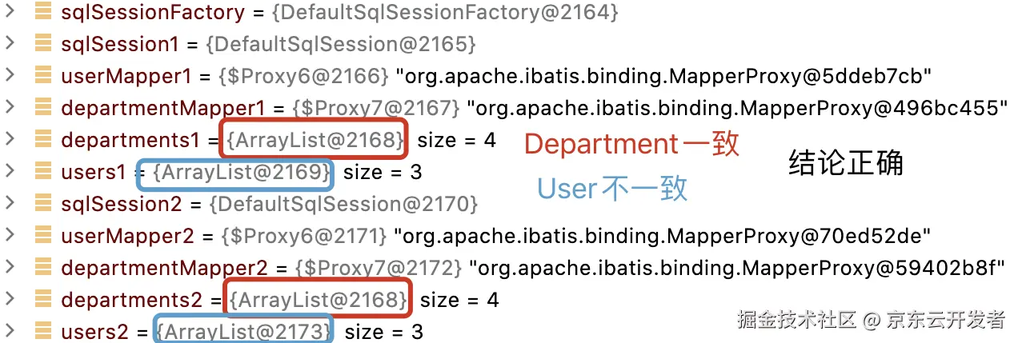



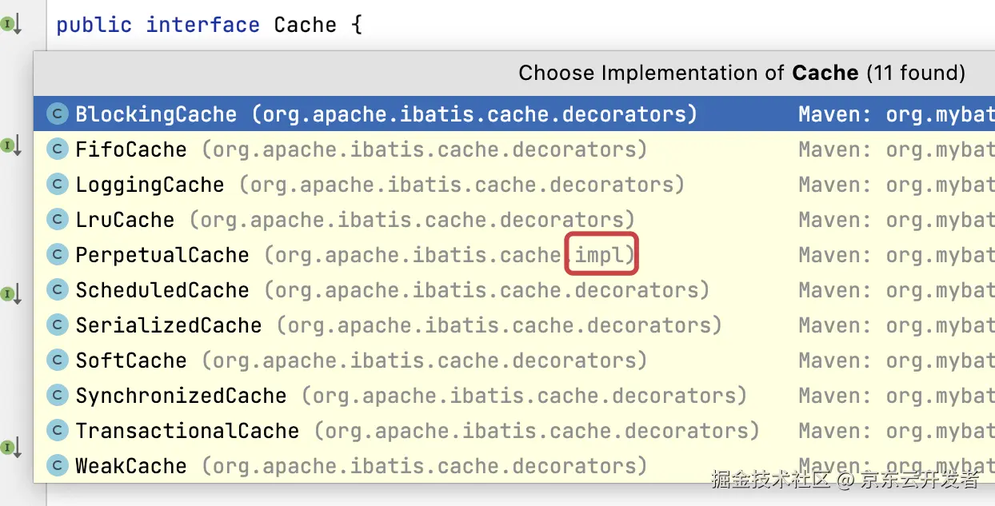
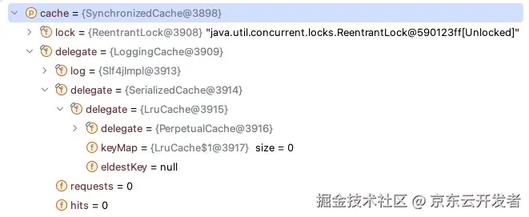
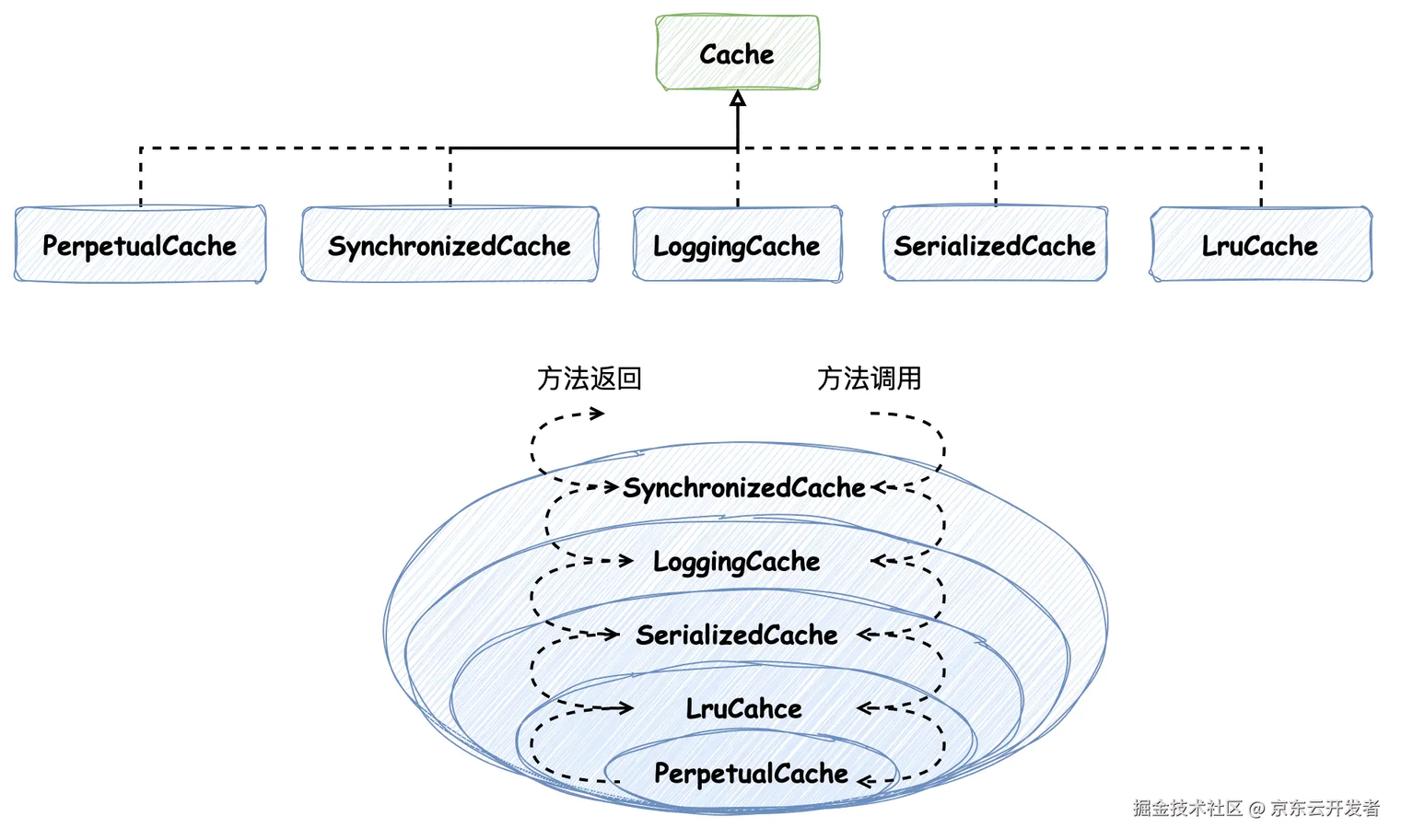
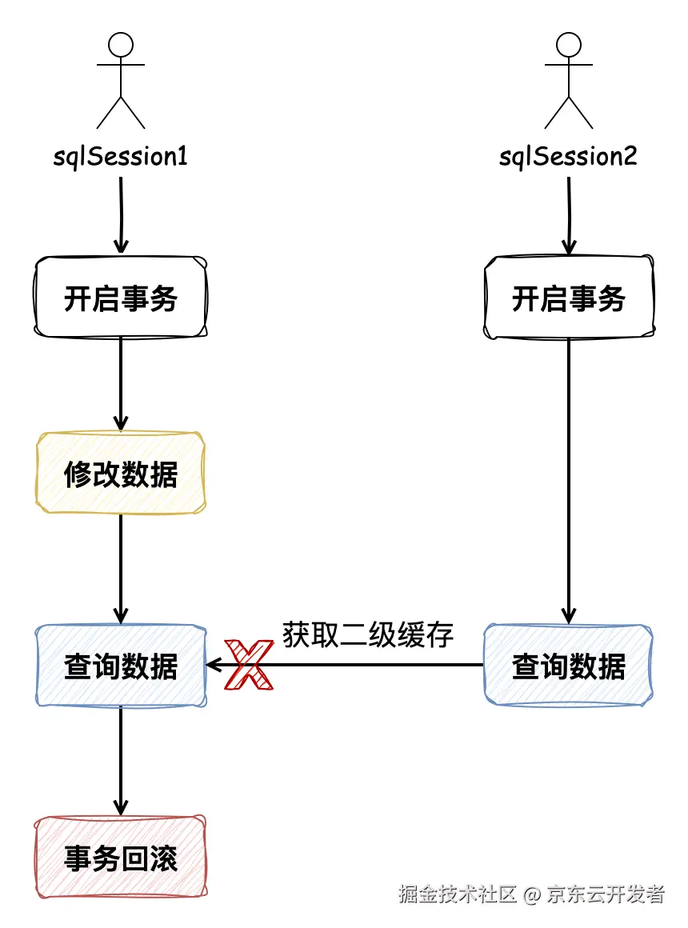










评论